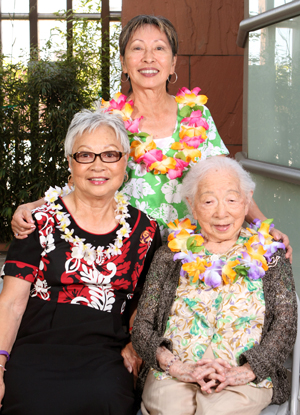
When the Wife and I have lunch in San Jose’s Japantown, we often notice Japanese Americans seniors eating there also. Some of the more notable buildings in San Jose’s Japantown are the Fuji Towers, an apartment complex for Japanese American seniors, and Yu Ai Kai, an activity center for seniors. Similar to the situation in Japan, the Japanese American population has been rapidly aging. Some 21.5 percent of the 1.3 million Japanese American population is over 65, making it this country’s oldest ethnic group. By comparison, the overall number of 65-plus U.S. residents is 12 percent. As this article from Rafu Shrimpo points out, the situation with Japanese Americans foreshadows what will happen to the US, to our parents, and in time, to ourselves.
The fact that Japanese Americans are unusually long-lived is one reason that the Japanese American community has dealt with elder care issues for some time. The article follows 77 year old Maggi Yaguchi, who has recently checked her mother, 99 year old Kikuyo Utsumi, into the Keiro senior health care facility. Keiro was founded over 50 years ago by Southern California Nisei community leaders who saw a need for a senior care facility for aging Issei. Today, Keiro operates five facilities, including nursing homes, intermediate care facilities, and a retirement home. Our very own Moye has a grandmother who lives in a Keiro facility. Other senior facilities like Fuji Towers in San Jose have been established in different parts of the country.
Keiro makes sure that their facilities are cultural sensitive (resulting in this rave review on Yelp), although residents needs have changed over the years. With the Issei, key issues were language and food, but now Nisei retirees are asking for poker and mah jong and want to watch Korean soap operas on television. “In the past, there was no way the residents would want to watch Korean TV,” recalls Shawn Miyake, president and chief executive officer of Keiro. Cultural sensitivity is important for seniors. After we made the difficult decision to put The Wife’s parents in a nursing home, I noticed that they would prefer to speak neither English nor Tagalog but their first language, Ilokano. We were lucky that the nursing home had many Ilokano speakers who made them feel more comfortable.
The Japanese American community has had the foresight to create institutions to provide for their seniors, but even these can’t meet demand, with Keiro having a two year waiting list. Keiro has a program, the Institute for Healthy Aging, that promotes healthy aging. I wish my parent-in-laws worked better on maintaining their health, as Maggi Yaguchi does. The 77 year old follows a personal fitness regimen that includes eating healthy and exercising both body and brain by golfing, getting involved at church, and volunteering at Keiro. She has endured a lot, including surviving breast cancer, losing a daughter to cancer, and having her husband killed by a drunk driver. She credits her faith for getting her through these times, and has taken out long-term health insurance to make sure that if she needs to go a nursing home, she won’t be a burden to her surviving sons. Unless we meet some untimely end, we will all eventually age, but even with organizations like Keiro, taking responsibility for our own health will make the process easier for ourselves and our families.
Photo Credit: Ken Matsui Images Photography featuring Maggi Yaguchi (left), her sister Aiko, and her mom Kikuyo.







